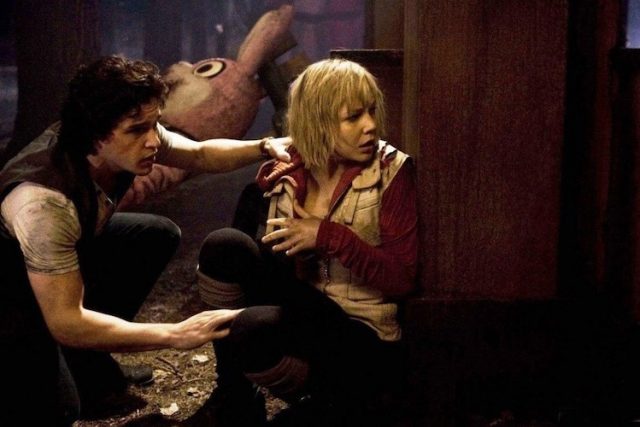
The movie “Silent Hill” has been a thorn in my side ever since it was released — first because it wasn’t good, and then because people kept citing it as the one video-game-based movie that was good. WHICH IT WASN’T. It may have been the least not-good of the bunch, but to call it “good” is a high compliment, by which I mean a compliment you can only make if you’re high.
I am vindicated by the sequel, “Silent Hill: Revelation.” Everyone agrees that this one is terrible, and according to the Internet’s Law of Retroactive Criticism, that means the original is terrible, too, having been ruined by the sequel through an anomaly in the space-time continuum unfamiliar to scientists but known to fanboys as the George Lucas Principle. So I was right all along, and everyone can eat it.
“Silent Hill: Revelation” picks up the story of “Silent Hill” six years later, or five years and eleven months after we forgot every detail of it. The little girl who was missing in that film, Sharon, is now 18 and named Heather (Adelaide Clemens), and she does not remember anything about her past. One of the things she does not remember, for example, is that a cult from the town of Silent Hill is looking for her so they can sacrifice her or impregnate her or whatever, because she’s the Chosen One or the fulfillment of prophecy or something. Heather and her dad, Harry (Sean Bean), have moved around a lot, and Heather thinks it’s because he killed somebody in self-defense and is running from the law, but the real reason is the cult thing. Heather’s mom (Radha Mitchell) is still trapped in another dimension, but Harry can see her in a mirror sometimes, so that’s nice.
Oh! I forgot to tell you: there are other dimensions in these movies. You can tell you’re in the bad dimension because there’s, say, a guy with a triangle for a head who wants to kill you, or a guy with circular saw blades protruding from his skull who wants to kill you. The way that you pass from our dimension to the bad dimension is by the screenplay just deciding to put you there sometimes. That is also how you travel back.
So anyway, Heather keeps popping back and forth between dimensions. One minute her high school hallway looks normal; the next minute it’s a decrepit cavern with faceless monsters lunging at her, and then also in some ways not a normal high school hallway. (No drugs.) Heather thinks she’s going insane, losing the ability to distinguish between dreams and reality. A classmate named Vincent (Kit Harington) tells her that dreams ARE reality, just different realities from the one you’re used to. This is a super-helpful thing to say to someone who’s afraid she’s losing her mind.
Heather is also afraid she’s being followed by a mysterious man, though this fear turns out to be well founded. The man is a private investigator hired by Silent Hill’s most popular cult to find Heather and tell her the truth about her past. The cult is hoping Heather will come back to Silent Hill on her own once she knows everything, but just to sweeten the pot, they abduct her father and write “COME TO SILENT HILL” on the wall in his blood. The persuasive technique is effective.
Heather heads for Silent Hill, accompanied by Vincent, even though Heather just met him at school today and doesn’t like strangers, or even people in general. (The movie went pretty well out of its way to establish this.) As they travel, Heather combs through the Silent Hill-related notebooks her father left behind and learns the whole story, not to mention a great deal about her father’s excellent penmanship.
Here’s where it gets confusing. By “here” I mean “when you decided to watch this movie.” Years ago, the cult in Silent Hill burned a little girl named Alessa who they thought was a witch, but she didn’t die, she just got really angry and created the hell dimension with the monsters. THIS IS WHY YOU SHOULD NOT BURN CHILDREN (or if you do, make sure you finish the job). But before Alessa turned completely into an evil demon, the last innocent part of her soul was transferred to a random newborn infant, who turned out to be Sharon/Heather, and they can’t destroy Alessa until she’s made whole again, which I guess means mushing her and Heather together. And they can’t just abduct Heather and drag her to Silent Hill — she has to go willingly, because the movie said so.
Then it turns out Vincent is a child of the cult who escaped from Silent Hill for the purpose of luring Heather back. But now that he’s met Heather and likes her, he feels bad. Totes sorry. Heather wanders though Silent Hill searching for the other half of a medallion she found in her dad’s stuff, encountering various monsters in the process in a way that is suspiciously similar to a video game. There is no rhyme or reason to when these monsters appear, or what tactics they use to harass Heather, which probably means the answer is “You’d know if you played teh video games!!!1!!” (This is the answer to a lot of questions lately.)
When Heather at last comes face to face with Alessa, she is able to overcome Alessa’s evilness with her own goodness. To be precise, she hugs Alessa very tight, and Alessa disintegrates. Hugging was her kryptonite! Lest you think the movie would end with such an anticlimax, however, Heather then has to face Vincent’s mother, the cult’s priestess, played by Trinity from “The Matrix” in an Edgar Winter wig. The way Heather defeats her is by standing aside and letting the Triangle Head monster destroy her. Heather’s main powers, then, are hugging and getting out of the way. Is that how it is in the video game, too? That doesn’t sound very exciting, but if it isn’t, then I guess the movie is a faithful adaptation.
— Film.com





